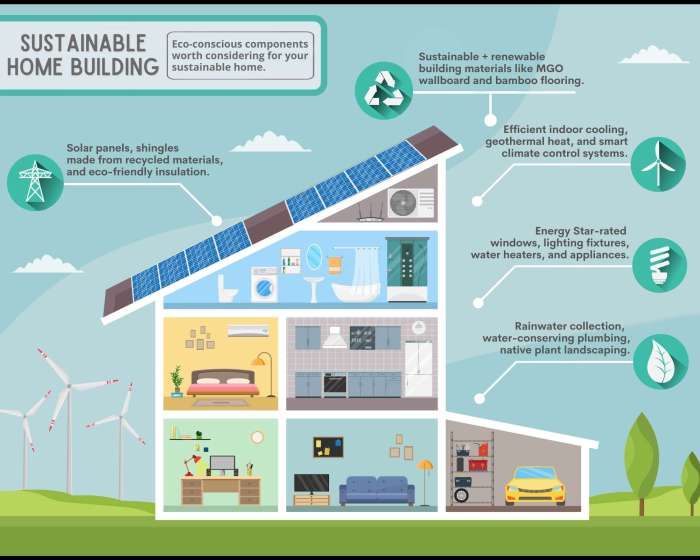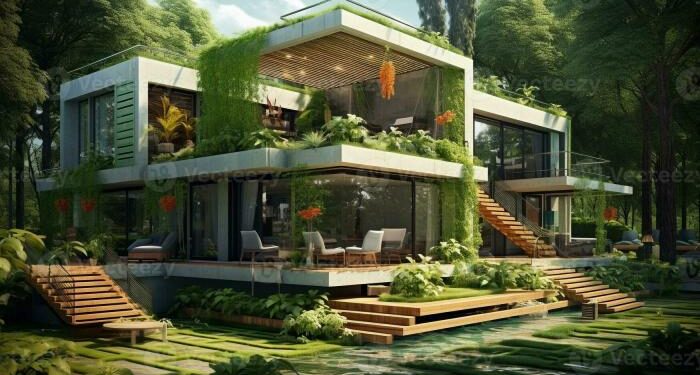Eco-Conscious House Design Trends for Smart Living sets the stage for this enthralling narrative, offering readers a glimpse into a story that is rich in detail and brimming with originality. From eco-conscious materials to energy-efficient features, this topic explores the innovative ways in which we can create sustainable homes for a smarter way of living.
As we delve deeper into each aspect, a world of possibilities unfolds, showcasing how small changes can make a big impact on our environment while enhancing our quality of life.
Eco-Conscious Materials
Using sustainable materials in eco-conscious house design is a key element in reducing the environmental impact of construction. These materials are sourced responsibly, often renewable or recycled, and are designed to have minimal negative effects on the planet.Incorporating recycled materials into the design of a house can significantly contribute to a greener living space.
By giving new life to materials that would otherwise end up in landfills, homeowners can reduce waste and promote sustainability. For example, using reclaimed wood for flooring or furniture not only adds character to a home but also helps conserve natural resources.
Comparing Environmental Impact
When comparing the environmental impact of traditional materials versus eco-friendly alternatives, it becomes evident that the latter have a much lower carbon footprint. Traditional materials like concrete and steel production release a significant amount of greenhouse gases into the atmosphere, contributing to global warming.
On the other hand, eco-friendly materials such as bamboo, cork, or recycled glass require less energy to produce and emit fewer harmful chemicals during manufacturing. This makes them a more sustainable choice for eco-conscious house design.
Energy-Efficient Features
Energy-efficient features play a crucial role in the design of eco-conscious homes, not only reducing the environmental impact but also helping homeowners save on utility costs. By incorporating energy-efficient appliances and systems, smart living design can significantly lower energy consumption.
Importance of Energy-Efficient Appliances
Investing in energy-efficient appliances, such as ENERGY STAR-rated refrigerators, dishwashers, and washing machines, can make a substantial difference in reducing electricity usage. These appliances are designed to operate more efficiently, consuming less energy while still providing the same level of performance.
Innovative Technologies for Energy Reduction
- Smart Thermostats: These devices can learn your schedule and adjust the temperature accordingly, optimizing energy usage.
- Solar Panels: Harnessing solar energy to power homes reduces reliance on traditional electricity sources.
- LED Lighting: Energy-efficient LED bulbs consume significantly less energy than traditional incandescent bulbs and have a longer lifespan.
Benefits of Passive Solar Design
Passive solar design uses the sun's energy to heat and light the home naturally, reducing the need for artificial heating and lighting. By strategically placing windows, utilizing thermal mass, and incorporating shading elements, passive solar design maximizes natural light and heat, creating a more comfortable and energy-efficient living environment.
Water Conservation Strategies

Integrating water conservation strategies into eco-conscious house designs is essential for sustainable living. By implementing innovative solutions, homeowners can significantly reduce their water consumption and contribute to environmental preservation.
Rainwater Harvesting Systems
Rainwater harvesting systems are a key feature of eco-conscious house designs. These systems collect rainwater from roofs and store it for later use, such as watering gardens, flushing toilets, or even for household chores. By utilizing rainwater, homeowners can reduce their reliance on municipal water sources, conserving resources and lowering utility bills.
Low-Flow Fixtures and Water-Saving Appliances
Incorporating low-flow fixtures and water-saving appliances is another effective water conservation strategy. These fixtures and appliances are designed to minimize water usage without compromising performance. From low-flow toilets and showerheads to energy-efficient dishwashers and washing machines, every little bit helps in reducing water wastage and promoting sustainable living practices.
Greywater Recycling Systems
Greywater recycling systems offer a sustainable solution for reducing water wastage in eco-conscious homes. These systems collect water from sources like sinks, showers, and laundry machines, filter it, and then reuse it for non-potable purposes such as irrigation or flushing toilets.
By recycling greywater, homeowners can further minimize their water footprint and contribute to a more environmentally friendly lifestyle.
Indoor Air Quality
Indoor air quality plays a crucial role in eco-conscious house design as it directly impacts the health and well-being of the occupants. Poor indoor air quality can lead to a variety of health issues, including allergies, respiratory problems, and even long-term health conditions.
Plants for Improved Air Quality
Plants are natural air purifiers that can help remove toxins and pollutants from the air. Some common plants known for their air-purifying properties include:
- Aloe Vera
- Spider Plant
- Snake Plant
- Peace Lily
These plants can be strategically placed throughout the home, such as in the living room, bedroom, or kitchen, to improve indoor air quality and create a healthier living environment.
Ventilation Systems for Healthy Living
Ventilation systems are essential in maintaining a healthy indoor environment by ensuring proper air circulation and reducing the build-up of pollutants. Proper ventilation helps remove stale air, moisture, and indoor pollutants, improving overall air quality. It is important to have a well-designed ventilation system that can efficiently exchange indoor air with fresh outdoor air, promoting a healthier living space for the occupants.
Smart Home Technology
Smart home technology plays a key role in enhancing eco-conscious house design by integrating advanced systems to optimize energy efficiency and resource management. The seamless integration of smart thermostats, lighting controls, and security systems allows homeowners to reduce their environmental impact while enjoying the benefits of home automation.
Integration of Smart Thermostats, Lighting Controls, and Security Systems
- Smart thermostats enable precise temperature control, adjusting settings based on occupancy and weather conditions to minimize energy consumption.
- Lighting controls offer customizable options for efficient lighting usage, such as dimming and scheduling, to reduce electricity usage.
- Security systems with smart features like motion sensors and remote monitoring not only enhance safety but also contribute to energy savings by activating lights only when needed.
Benefits of Home Automation
- Optimizing resource usage: Smart home technology allows for better management of energy, water, and other resources, leading to reduced waste and lower utility bills.
- Reducing environmental impact: By automating energy-efficient practices, homeowners can significantly decrease their carbon footprint and contribute to a more sustainable future.
Last Point
In conclusion, Eco-Conscious House Design Trends for Smart Living presents a compelling case for embracing sustainability in our homes. By incorporating eco-friendly materials, energy-efficient features, water conservation strategies, indoor air quality improvements, and smart home technology, we can create living spaces that are both environmentally friendly and technologically advanced.
This holistic approach to design not only benefits the planet but also enhances our well-being, paving the way for a brighter future.
Essential Questionnaire
How can recycled materials contribute to a greener living space?
Recycled materials reduce the need for new resources, lower carbon emissions, and minimize waste, making them an eco-conscious choice for sustainable living.
What are the benefits of passive solar design for maximizing natural light and heat?
Passive solar design utilizes sunlight to heat and light homes, reducing energy consumption and promoting a comfortable living environment.
How can rainwater harvesting systems be integrated into eco-conscious house designs?
Rainwater harvesting systems collect and store rainwater for various household uses, reducing reliance on municipal water sources and promoting water conservation.
What role do ventilation systems play in maintaining a healthy living environment?
Ventilation systems help circulate fresh air, reduce indoor pollutants, and regulate humidity levels, creating a healthier indoor environment.
How does smart home technology enhance eco-conscious house design?
Smart home technology allows for better energy management, increased efficiency, and improved control over various systems, contributing to a more sustainable living space.




